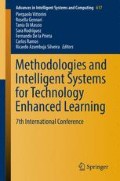Abstract
Predicting students’ performance is a popular objective of learning analytics, aimed at identifying indicators for learning success. Various data mining approaches have been applied for this purpose on student data collected from learning management systems or intelligent tutoring systems. However, the emerging social media-based learning environments have been less explored so far. Hence, in this paper we present an approach for predicting students’ performance based on their contributions on wiki, blog and microblogging tool. An innovative algorithm (Large Margin Nearest Neighbor Regression) is applied, and comparisons with other algorithms are conducted. Very good correlation coefficients are obtained, outperforming commonly used regression algorithms. Overall, results indicate that students’ active participation on social media tools is a good predictor of learning performance.
Access this chapter
Tax calculation will be finalised at checkout
Purchases are for personal use only
References
Baker, R.S., Inventado, P.S.: Educational data mining and learning analytics. In: Larusson, J.A., White, B. (eds.) Learning Analytics: From Research to Practice, pp. 61–75. Springer, New York (2014)
Dyckhoff, A.L., Lukarov, V., Muslim, A., Chatti, M.A, Schroeder, U.: Supporting action research with learning analytics. In: Proceedings of the LAK 2013, pp. 220–229. ACM Press (2013)
Fancsali, S.: Variable construction for predictive and causal modeling of online education data. In: Proceedings of the LAK 2011, pp. 54–63. ACM Press (2011)
Ferguson, R., Brasher, A., Clow, D., Cooper, A., Hillaire, G., Mittelmeier, J., Rienties, B., Ullmann, T., Vuorikari, R.: Research evidence on the use of learning analytics - implications for education policy. In: Joint Research Centre Science for Policy Report (2016). doi:10.2791/955210
Hall, M., Frank, E., Holmes, G., Pfahringer, B., Reutemann, P., Witten, I.H.: The WEKA data mining software: an update. ACM SIGKDD Explor. 11(1), 10–18 (2009)
Leon, F., Curteanu, S.: Evolutionary algorithm for large margin nearest neighbour regression. In: Proceedings of the ICCCI 2015. LNAI, vol. 9329, pp. 286–296. Springer (2015)
Leon, F., Curteanu, S.: Large margin nearest neighbour regression using different optimization techniques. J. Intell. Fuzzy Syst. 32(2), 1321–1332 (2017)
Popescu, E.: Providing collaborative learning support with social media in an integrated environment. World Wide Web 17(2), 199–212 (2014). Springer
Roberge, D., Rojas, A., Baker, R.S.: Does the length of time off-task matter? In: Proceedings of the LAK 2012, pp. 234–237. ACM Press (2012)
Steiner, C., Kickmeier-Rust, M. Türker, M.A.: Review article about LA and EDM approaches (Deliverable D3.1) (2014). http://css-kmi.tugraz.at/mkrwww/leas-box/downloads/D3.1.pdf
Wang, Y.H., Liao, H.C.: Data mining for adaptive learning in a TESL-based e-learning system. Expert Syst. Appl. 38(6), 6480–6485 (2011)
Weinberger, K.Q., Saul, L.K.: Distance metric learning for large margin nearest neighbor classification. J. Mach. Learn. Res. 10, 207–244 (2009)
Wolff, A., Zdrahal, Z., Nikolov, A., Pantucek, M.: Improving retention: predicting at-risk students by analysing clicking behaviour in a virtual learning environment. In: Proceedings of the LAK 2013, pp. 145–149. ACM Press (2013)
Xing, W., Guo, R., Petakovic, E., Goggins, S.: Participation-based student final performance prediction model through interpretable genetic programming: Integrating learning analytics, educational data mining and theory. Comput. Hum. Behav. 47, 168–181 (2015)
Acknowledgements
This work was supported by a grant of the Romanian National Authority for Scientific Research and Innovation, CNCS – UEFISCDI, project number PN-II-RU-TE-2014-4-2604.
Author information
Authors and Affiliations
Corresponding author
Editor information
Editors and Affiliations
Rights and permissions
Copyright information
© 2017 Springer International Publishing AG
About this paper
Cite this paper
Leon, F., Popescu, E. (2017). Using Large Margin Nearest Neighbor Regression Algorithm to Predict Student Grades Based on Social Media Traces. In: Vittorini, P., et al. Methodologies and Intelligent Systems for Technology Enhanced Learning. MIS4TEL 2017. Advances in Intelligent Systems and Computing, vol 617. Springer, Cham. https://doi.org/10.1007/978-3-319-60819-8_2
Download citation
DOI: https://doi.org/10.1007/978-3-319-60819-8_2
Published:
Publisher Name: Springer, Cham
Print ISBN: 978-3-319-60818-1
Online ISBN: 978-3-319-60819-8
eBook Packages: EngineeringEngineering (R0)

